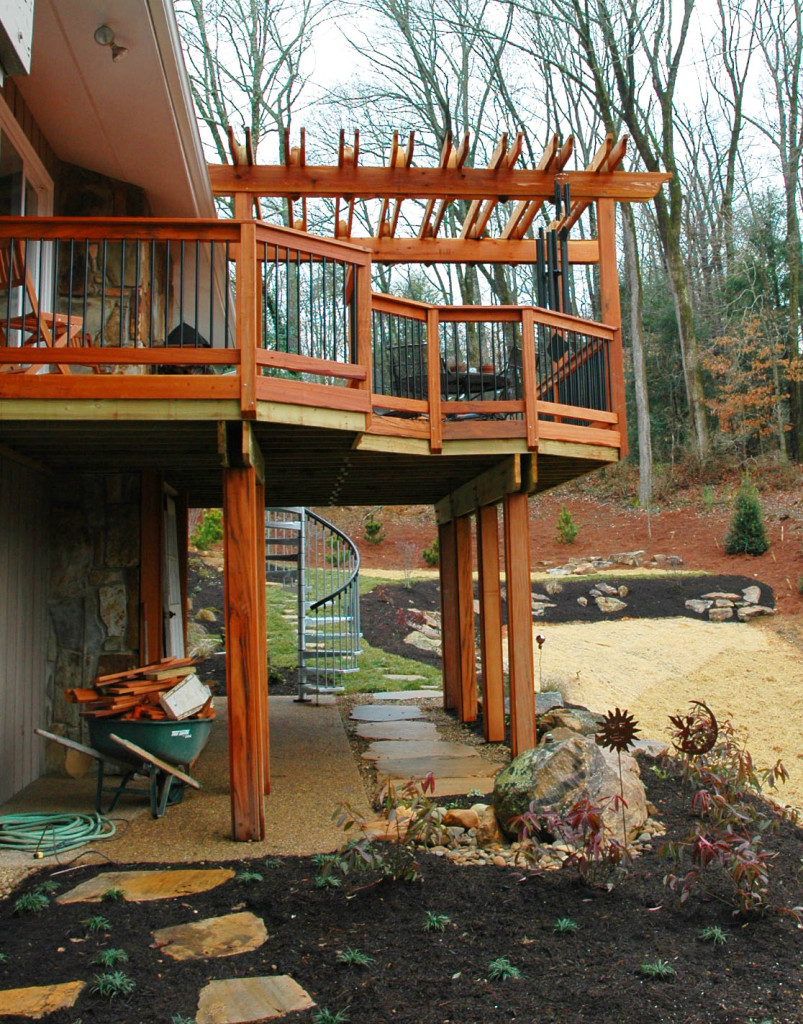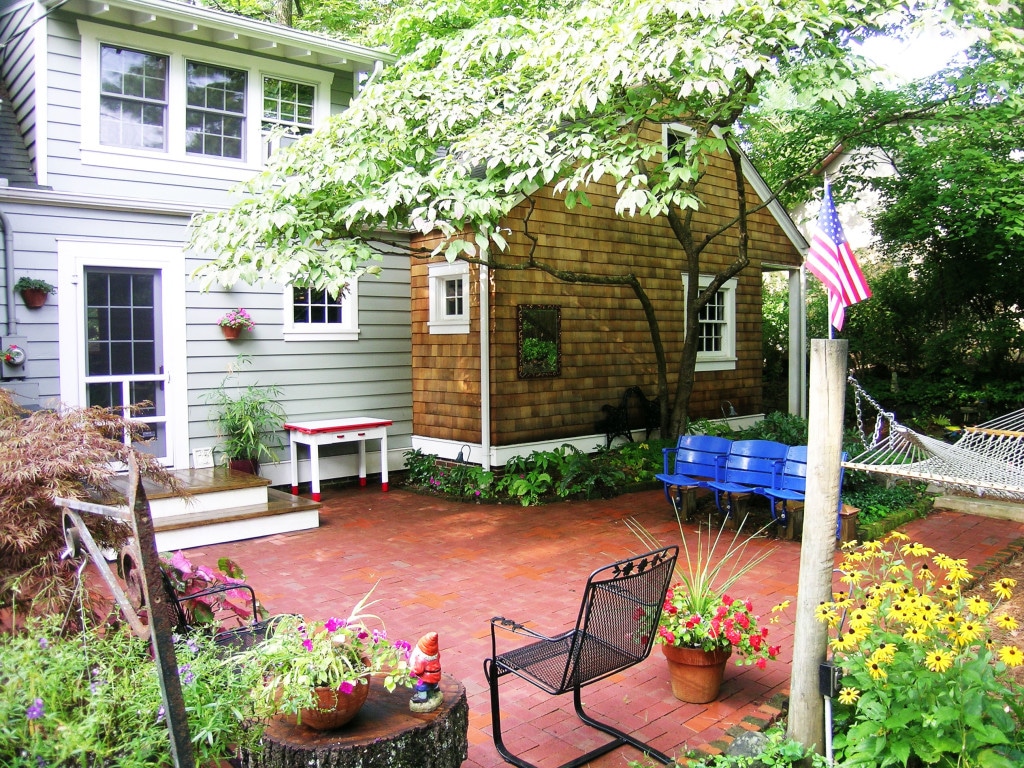How Hardscapes Bring Balance and Harmony to a Home Landscape Design
A hardscape is any landscaping feature that’s made of stone, wood, concrete or some other solid material. With that said, a hardscape can be used for both functional and aesthetic purposes in one’s garden, landscape design or backyard.
Creating a hardscape is a combination of art and science but when done right, it can elevate the value and feel of one’s home.
This piece will take a look at how homeowners can incorporate hardscapes into their very own backyard to create a contemporary landscape design.
What Are Common Characteristics & Features of a Hardscape?
A hardscape can take the form of a rustic paradise with natural wood elements, or a “stone haven” with masterful rock and masonry.
It’s cliche to say this, but the possibilities are quite limitless. The best way to see the possibility transform into an opportunity is by looking at some of the more popular hardscape features.
What Are Some Common Hardscape Features in Home Landscape Design?
- Stone retaining walls
- Concrete patios
- Brick patios
- Flagstone patios
- Tile patios
- Stone walkways
- Gravel paths
- Boulder features
- Metal or wood fences
- Wooden decks
- Site furnishings such as arbors or gazebos or pergolas
Water features (and arguably, fire pits) can also serve as hardscape features. It might sound odd because water itself isn’t hard (unless you’re referring to its mineral content), but the structures used to hold water can be considered a hardscape feature. They might include the following:
- Stone fountains
- Ceramic fountains
- Inexpensive DIY fountains
- Clay pot fountains
Let me show you examples of these hardscape features; hardscapes I’ve worked on myself to create gardens and outdoor rooms that work harmoniously with the landscape:

A functional stone pathway embedded into the greenery not only provides an easy way to walk up to your home but also creates a visual contrast that ensures a garden doesn’t appear monotonous.

This example demonstrates the possibilities of mixing different types of materials. In this case, you can see how the mix of brick and wood features complement each other. This will look especially more striking once the planted flowers in the fresh soil start to bloom.

Here’s my last example. It’s a common sight here in Tennessee (and throughout the country) because it can also be a cost-effective option. The interlocking pattern and rouge tone make this brick patio a vibrant choice. The red bricks work with the greenery, the bright yellow sunflowers and even the white and red outdoor table to present a personable space that comes together. Notice the rescued baseball stadium seating.
These three examples are just a taste of what you can do with hardscapes on your property. A little creativity and inspiration are all you need to transform your backyard into the landscape of your dreams.
But of course, you also have to think about the implementation phase – actually bringing your vision to life.
What Are Some Advantages to Building a Hardscape?
A hardscape may sometime seem like a luxury when it comes to home design, but you shouldn’t see it as an afterthought.
Creating comfortable spaces for people and social interaction is critical to garden design success. It can also bring a great return on investment, in many ways.
Benefits of Incorporating Hardscape in Home Landscape Design
- Increases property value
- Defines your property with visual borders and focal points
- Help you direct foot traffic
- Create shade and privacy
- Reduce gardening/landscape maintenance
- Reduces soil grade and erosion issues
- Enhances the overall design aesthetic of your home
Executing a Hardscape in Contemporary Landscape Design
Some hardscape projects will require relatively light work, while others will take substantial effort. It requires a lot of planning and thoughtful execution. So that’s why I stress following a step-by-step plan to make a hardscape installation easier to handle.
Take a Good Look at Your Current Landscape Design
You first need to consider the state of your landscape as it stands before you. Certain hardscape features will be a good fit for your home, while others may not be.
The size, shape, and topography of your home landscape will influence whether a hardscape structure will work for you. So that gravel path or stone tiling you saw at a home in a neighborhood nearby, may not work in your situation if your property has a substantial slope. (loose gravel is like water, it runs downhill).
You need to plan your design and then see how it fits with your property’s dimensions. It’s also worthwhile consulting a professional landscape architect who can help you determine whether the desired hardscape feature will work for your own home.
Solve Draining Issues Before They Drain You
Poor drainage on a property can cause more damage to a hardscape than any other factor. You need to consider how the drainage will impact the hardscape feature you plan to install.
There’s also the environment. The drainage system should allow for runoff so that you can capture water for reuse. Also, consider a permeable pavement system that will allow stormwater to percolate rather than have to be carried off-site.
Find a Focal Point and Stick to It
If you look at the examples of hardscapes pictured above, you’ll notice that there is a standout feature or element. For example, the first image example above was a stone walkway. In the second one, it’s the wooden deck; while in the third, it’s the patio material itself.
The point I’m trying to get across is that there is a focal point, one defining feature or area that should draw attention and cut through the landscape to create visual dominance.
Ideally, that feature will be the thing that makes visitors pause (and hopefully give praise). Any feature could be that focal point.
Choose Complementary Materials
Here’s where hardscapes truly shine in their ability to create balance and harmony. You can achieve this balance and harmony by playing around with the arrangement of certain features, not to mention, the shape of these features themselves.
There’s also the juxtaposition, the side by side placement, of two contrasting elements. One of the easiest ways to do this is by placing natural elements (ie. wood, plant) next to a man-made element (ie. metal, gravel).
It takes a combination of personal taste and an artistic eye to create a visually appealing hardscape but if it’s not your strong suit, you can always seek some outside help.
Incorporate the Greenery
Another way in which hardscapes can bring balance and harmony is by placing inorganic material (ie. stone, metal) with organic materials (ie. trees, plants) together. Some combinations just work well together.
A good example of this is the use of stones and rocks to frame shrubs and flowerbeds. You’ve likely seen this type of arrangement before and you’ll agree that the natural or stone colors stand well with the various shades of green. Even the placement of a custom-crafted pergola can add a sharp contrast to the brilliant green lawn.
Choose the Right Materials for Aesthetics
Hardscape design is heavily influenced by the choice of materials you use. They contribute not only to the durability of hardscape structures but also the way those structures stand out in comparison to other features in your garden. They can also establish a design style (ie. Contemporary vs. rustic).
Speaking of style, it helps to define the style you want for your hardscape. This will largely coincide with the style of your home’s architecture, and working with a landscape architect can help you choose the right design aesthetic for your backyard.
You can also learn more about house design styles here – there are at least 33 recognized styles you can dabble with when matching your home to the desired outdoor style intended.
Choose the Variety of Materials
With that said, you can choose from various materials such as brick or stone, and of course, you can incorporate a mix of these materials. The best hardscape designs feature a combination of at least one or more colors and materials.
For example, a monochromatic scheme usually looks too plain. Building a visually appealing hardscape is very much like assembling a striking new wardrobe; add color and contrast where you can so everything doesn’t look the same. You want the colors and materials to complement not only each other but also the interior and exterior design of your home.
Also, you want to think about having a combination of different textures since that sort of arrangement can enhance your garden’s visual aesthetic as well. For example, you can mix rustic wood features with stone masonry for a combination of smooth and edgy features.
Keep the Greenery
Here’s the kicker with a hardscape: even though it is a work of human construction, a hardscape must come with generous amounts of garden vegetation.
I’ve seen a lot of homeowners who build these beautiful hardscapes that have little or no greenery at all, making it look “parched” and “arid”. At the very minimum, design your hardscape to allow ample room for some container plantings.
When I design hardscapes I often include “pot ears”, extensions of the paving materials to accommodate decorative planted containers or urns.
In general, greenery belongs in every hardscape because it adds an array of natural colors that humans can’t replicate in wood, stone or metal. Just think about the beauty of a shrub or flower bed that frames a man-made hardscape – the greens, yellows and pinks highlighting the darker browns, greys and black. Plus added vegetation means more emitted oxygen and carbon sequestration. In other words, fresh, clean air.
It’s what nature does best.
Hardscapes in Contemporary Landscape Design
A beautifully lush backyard is the hallmark of an appealing backyard.
Dense foliage, vibrant flowers and budding trees, without a doubt, breathe life into your property. However, true beauty (and function) in a backyard comes from having a balance of other elements such as stone, wood, metal and brick.
A hardscape allows you to incorporate these materials into artfully crafted outdoor rooms that make it easier to navigate through and appreciate your oasis. The satisfaction that comes with building one is well worth the effort.
Need help planning your hardscape project? Get in touch with me so that we can get you started!






